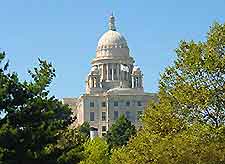Providence History Facts and Timeline
(Providence, Rhode Island - RI, USA)

Providence, the capital of Rhode Island, has a long history dating back to 1636. It was first settled by Roger Williams, a theologian, and became one of the USA's original Thirteen Colonies. Williams successfully negotiated with the original occupiers of the land, the native Pokanoket tribe, and managed to change the area's name to Providence.
The settlement's growth was slow during these early days, with a number of conflicts and inefficient agricultural lands all contributing to its slow development. Nowadays, visitors can explore the site of the First Baptist Church in America, opened in 1638 by Williams and later rebuilt in the 1770s.
British Taxation
The 1700s were a dark time in Providence history, thanks to the aggressive taxation on fishing and agriculture by the British. These industries were mainstays of the local economy, and taxation on them led the Providence population to turn against their colonial masters.
The city's distilleries were also disadvantaged by the Sugar Act, introduced in 1764, which was in effect a tax on the rum trade. Eventually, the unrest among the locals turned into violence, culminating in the Gaspée Affair. This event, in which a British customs boat was attacked and looted in 1772, is remembered by a plaque on North Main Street.
The Revolutionary War
The American War of Independence (1775 to 1783) was not only a significant event for the future USA, but it was a key event in the history of Providence. Despite the city being at the forefront of a previous rebellion against the British, it managed to avoid occupation by British forces. However, French forces are known to have used Providence on their way to fight the British.
After the war ended, Providence became one of the top-ten largest cities in the country, with a strong focus on its growing manufacturing base. Construction on the Old State House was finished in 1762 and this Georgian-style building remains one of the city's most-visited attractions. It is located in the historic East Side district, where the city's most interesting architecture can be found.
The 1800s
This period saw mixed fortunes for the city of Providence. Despite its growing manufacturing base, wealth divisions led to tensions among sections of the population. Race riots were a problem in the 1820s, highlighting divisions between white European immigrants and the resident black population. After the Civil War however, the city continued to grow, resulting in a population of around 176,000 residents by the end of the 19th century.
Hard Times
The peak manufacturing period in Providence history came to a dramatic close at the end of the 1920s. The city had already begun to move away from heavy industry into niches such as jewelry manufacture, but the Great Depression hit the city as severely as anywhere else in the US. Subsequently, flooding in 1938 required great resilience from local residents. After WWII, the city was inundated with crime syndicates and it wasn't until the 1970s that Providence became a desirable place to live once more.
Modern Developments
Huge investment during the 1970s, '80s and '90s led to the construction of several parks and huge shopping malls, such as Providence Place. This mall is the biggest in Rhode Island and one of the biggest in the southern New England region.
During this time, the city's rivers were revived too, meaning that developers could produce sites such as Waterplace Park. This urban park features riverside walks in a Venetian style, as well as classical music events in the summer. Luxury yachts also make their summer home in the marinas of Rhode Island, adding further wealth and glamour to Providence.
 Providence, the capital of Rhode Island, has a long history dating back to 1636. It was first settled by Roger Williams, a theologian, and became one of the USA's original Thirteen Colonies. Williams successfully negotiated with the original occupiers of the land, the native Pokanoket tribe, and managed to change the area's name to Providence.
Providence, the capital of Rhode Island, has a long history dating back to 1636. It was first settled by Roger Williams, a theologian, and became one of the USA's original Thirteen Colonies. Williams successfully negotiated with the original occupiers of the land, the native Pokanoket tribe, and managed to change the area's name to Providence.